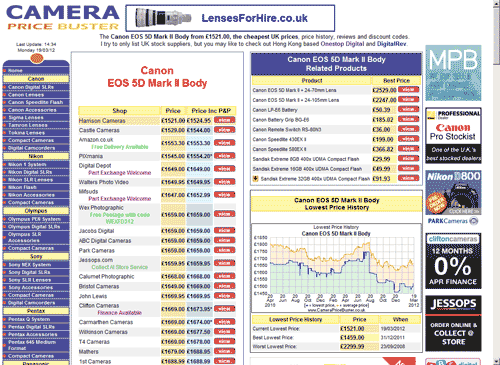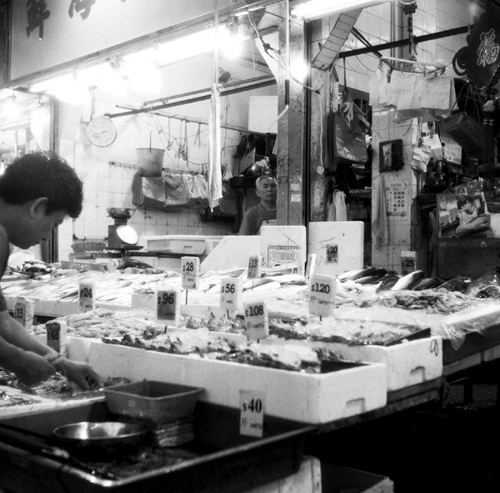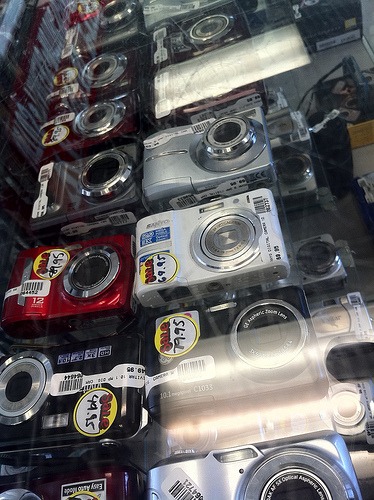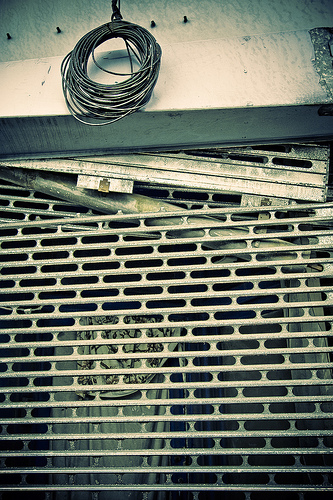Tips for buying cheaper cameras, lenses, and accessories
Digital photography gear can be quite expensive, so it makes sense to save money if you can. Even a relatively small saving, like 10% could result in smaller dent in your wallet.
Buying online
For purchasing new photography equipment, it is often cheaper to purchase online than in a bricks and mortar store. This is because online shops don't have the overheads of having to pay the high rental costs for a shop front.
There are a lot of websites selling cameras and lenses online, so how do you find out which is cheapest? Camera price buster US and Camera price buster UK both gather prices on camera equipment from a range of retailers, and then list the cheapest on their website. You can also view prices of an item on a graph, to see whether the price has been dropping or increasing lately.

Camera Price Buster UK website showing current cheapest prices and graph of previous prices for the Canon 5D MkII camera
Another good comparison website is Google shopping. Though Google is not quite so good as you will often find their listings filled with hundreds of accessories and unrelated items. If you are searching for a camera or lens, sort the items by price. Then flick through the pages until you find where the listings for the item you want actually start.
Check seller ratings
It is very important to check seller ratings, particularly when ordering online. Google shopping will give you a link to the seller's rating from the product page. You can also just google for 'seller name review' to find reviews of the seller.
Some sellers are not legitimate. It is not worth saving any amount of money on a purchase if you will never receive what you paid for. I would also highly recommend you pay by credit card, even with a trusted seller. If there are any problems, and the seller refuses to issue a refund, or is very slow in dealing with your issue, you can contact your credit card provider for a refund.
Gray market goods
There are several websites, most based in Hong Kong, that sell goods meant for the Asian market worldwide. Camera manufacturers often practice geographical price discrimination. They price their goods differently for different areas of the world, considering how much they think consumers in each area of the world are willing to pay.
This means that the same goods are often more expensive in the US, Europe, and Australasia than they are in Asia. So by buying photography equipment meant for the Asian market, you can often save quite a bit of money. The two most well known websites that sell gear like this are DigitalRev, Onestop Digital.
Products sold unofficially outside of their intended market like this are known as 'gray market goods'.

wet market by a God's Child on flickr (licensed CC-BY-ND)
The main disadvantage of purchasing gray market goods is that the warranty is usually only valid in the country the goods were intended to be sold in. If something goes wrong with your camera, you'll often need to send it back to the retailer in Hong Kong to get it fixed. Not very convenient or cheap.
Another problem can be with import taxes. The price charged by these websites does not usually include any taxes you would have to pay if purchased within your own country. You may have to pay these taxes, plus an administration charge when you receive the item. If you are considering purchasing a camera from a website outside of your own country, check with them if this could be an issue.
eBay
eBay can be a good source for both new and second hand cameras and lenses at discount prices. As with other websites, check seller ratings, and if you are purchasing a new product, check the warranty details and any taxes you may have to pay.
When purchasing goods via eBay, only pay by paypal or cash on collection if you are going to pick the item up from the seller. eBay often has problems with hacked accounts. These usually sell expensive items at very reduced prices e.g. top end cameras and lenses.
Then in the auction text, it asks you to contact them if you want to buy the item. If you do this, the seller will ask you to send them the money by wire transfer. Then you will never hear from them again.
Because these scammers operate from hacked accounts, the seller may often have very good feedback. Check what items the seller normally sells. Someone that normally sells baby clothes and now suddenly has high end cameras and lenses they are selling should ring alarm bells.
Classifieds
Classified ads, such as Craigslist, similar local websites, and the sales sections of local papers and classified ads directories can be a good place to find cheap camera equipment. These have the added benefit that it is usually a local seller, so you can go and inspect the item you want before committing to purchase it.
Pawn brokers
Again, pawn brokers will usually let you inspect the camera or lens you are looking at before you purchase it. Often they will have a money back guarantee period as well, so if the camera packs up a couple of days after you bought it, you should be able to get a refund.

Digital Cameras in an OKC Pawn Shop by Wesley Fryer on flickr (licensed CC-BY-SA)
Buy an older model
When considering purchasing a new camera or lens, also look at how much the previous model cost. This is particularly relevant for digital camera, which are updated on a regular basis.
Last year's camera model may not be quite as good as the latest model, but it may be half the price (or even less) than the new model.
However, I would suggest only looking at older cameras released in the last few years. Camera technology moves very quickly, and a cheap basic camera today may be better than a professional camera from 6 years ago.
Look for bundles
If you are wanting to buy a lens or lenses for your camera, look out for cameras and lenses being sold together as a bundle. You can make some significant savings compared to buying the items individually.
A particular tip is to look for lenses being sold with film cameras. Film cameras often receive less attention than digital cameras, and so you may be able to get a better price. Even if you don't want the film camera, the lack of offers from other buyers because it is listed under film means you can grab a bargain. Make sure the lenses are compatible with your digital camera before you buy though.
What to look for in a second hand model
If you are buying a lens, or camera with integrated lens, check for any scratches on the front and back elements of the lens. Also check if there is any fungus in the lens (small white splotches or spider web patterns). Fungus is very difficult to get rid of, and can spread to other lenses - purchasing a lens with a fungus problem is probably not worth it.
Lenses often collect a small amount of dust. This is normal, and should not effect image quality. But it could cause a problem if there is a lot of dust inside the lens.
Check the camera / lens operates okay, making sure to test all the functions (at least all the ones you will use).
For a camera check / ask for the shutter count. You can google for the model name of the camera you are looking at purchasing to find its expected shutter life.

crisis by batintherain on flickr (licensed CC-BY-SA)
If a camera's shutter is rated at 120,000 and the camera has already done 150,000 shots, then you need to take this into account when considering the price. Likely the shutter will need replacing shortly, so add this cost onto the asking price to see how much the camera will really cost you.
Purchasing cameras, lenses, and other accessories online or second-hand can give you some good savings. Doing a bit of research and using common sense can make sure you don't get ripped off by the few scammers that are out there, and your wallet will thank you.
If you have a bricks & mortar photography store nearby, don't totally discount them. They may well be able to offer you a reduced price if you negotiate with them. And the advice they can provide may be worth more than the savings on the equipment you are purchasing.




